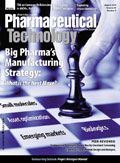Report from Asia
Manufacturers and regulators on both sides of the ocean move to ensure the safety of heparin and other globally distributed drug products.
Recently, members of US House of Representatives asked the US Food and Drug Administration to provide a statement regarding its inspection of heparin manufacturers in China. The House also asked FDA to demonstrate its level of cooperation on safety standards with its Chinese counterpart, the State Food and Drug Administration (SFDA).
In 2008, the active pharmaceutical ingredient (API) in Baxter International's (Deerfield, IL) heparin was found to be contaminated with oversulfated chondroitin sulfate, supplied by Scientific Protein Laboratories' (SPL) Changzhou, China, facility. More than 80 people around the world died as a result of the contamination.

(PHOTO: PETER ADAMS, DIGITAL VISION, GETTY IMAGES)
Given the seriousness of the issue, drug manufacturers have been increasing efforts to address heparin quality and safety. "Companies are now more focused on the need for assuring supply chain [safety] such as employing competent personnel to perform audits on suppliers and conduct thorough investigations on manufacturing sites and systems," says Dr. Bernd Renger, member of the Board of the European Compliance Academy (ECA) Foundation and chairman of one of its interest groups, the European Qualified Person Association, an independent membership association for quality personnel focused on good manufacturing practice (GMP) and regulatory affairs. "It is also interesting to see whether this issue and skepticism will affect business decisions. After all, it is a global issue with implications for brokers and importers," he said.
Looking back, the US Pharmacopeia revised its heparin sodium and heparin calcium monographs and their related reference standards in the summer of 2008. A second stage of revised tests and accompanying reference materials harmonized dosage measurement units, added new methodologies for identification as well as a new potency assay and additional impurity tests. The second-stage revisions were released in October 2009. A third stage of USP revisions to the existing heparin standards involving laboratory research is in progress.
SFDA and Chinese manufacturers are also becoming more proactive in ensuring heparin quality in the country by enforcing tougher quality control procedures in production. For example, a Chinese safety representative from National Institute for Control of Pharmaceutical and Biological Products participated in a recent USP meeting to help draft a heparin monograph (now approved) to set purity standards for the ingredient.
Chinese manufacturers such as Donying Tiandong Biochemical Industry (Donying, Shandong) introduced a capillary electrophoresis instrument to analyze heparin products based on the US FDA's guidelines and also contracted a local university research laboratory to conduct the analysis. Leading domestic manufacturer Shenzhen Hepalink (Nanshan District, Shenzhen) built a factory based on FDA's requirements and enforced a more strict set of rules to ensure quality and safety, including tracking the sources of its raw materials and placing its employees in quality-assurance laboratories of suppliers' premises.
Generally, purity standards have improved since last year, according to Jian Liu, associate professor of medicinal chemistry and natural products from the University of North Carolina at Chapel Hill. He adds, "These purity standards apply to active pharmaceutical ingredients (APIs) entering the US. The protein and nucleic acid contamination levels have been reduced. Global heparin manufacturers are also required to demonstrate that the final product does not contain oversulfated chondroitin sulfate. Although there is still room for setting up even higher standards to improve the purity, we also need to consider if higher purity standards are economically and commercially feasible."
The heparin scandal highlighted the importance of analytics and information technology (IT) throughout the industry. Jamie Velez, head of Supply Chain Management Practice at Tunnell Consulting, a pharmaceutical consulting firm based in Pennsylvania, noted that it is important to implement tracking systems that help maintain visibility within the supply chain. In fact, he says there is a lot of pressure for companies to replace older pharmocopeial identification and authentication methods with cutting-edge technologies. Some newer methods such as nuclear magnetic resonance are mentioned in the latest USP, and European Pharmacopeia heparin monographs.
Renger adds, "Industry and regulatory authorities should put greater emphasis on site inspections by exploring measures like joint audits to share cost and resources. The activities of Rx-360 [the international pharmaceutical consortium for supply-chain security], APIC [the API Committee that falls under the European Chemical Industry Council], IPEC [the International Pharmaceutical Excipient Council], and IPEA [International Pharmaceutical Excipient Auditing] are valuable contributors to lead to this desired result as is the [Australian-European-US] pilot project to rationalize the international GMP inspection activities. Also, the importance of a comprehensive technical or quality agreement cannot be overstated even if the lack of language knowledge, resources, and expertise may open issues for policing it."
Renger feels that strict control and continuous surveillance based on local expertise and intelligence should be enforced rather than the more common practice of conducting a two-day audit of an offshore supplier every two years. Therefore, the opening of US FDA offices in Beijing, Shanghai, and Guangzhou in 2008 must be considered another step in the right direction.
While industry and regulators work to improve supply-chain safety to prevent another global contamination incident, some companies are looking for alternatives. Researchers at the University of North Carolina at Chapel Hill have produced a version of synthetic heparin that does not involve the use of animal tissues. This version minimizes production interference and ensures safety in the case of a disease outbreak. Also, synthetic heparin can be synthesized in manufacturing sites under GMP regulation and easily inspected by regulatory agencies. Synthetic heparin is still manufactured on a milligram level compared with the 100 tons required per year by industry, but steps forward in this area could revolutionize heparin manufacture, Renger says.
Jane Wan is a freelance writer based in Singapore.

Pharmaceutical Tariffs Are Imminent: How Industry is Bracing for Impact
April 16th 2025On April 14, 2025, the Trump Administration launched a national security-driven investigation into pharmaceuticals, a move that will likely result in tariffs being placed on pharmaceutical drugs, ingredients, and other components that are imported from outside of the United States.